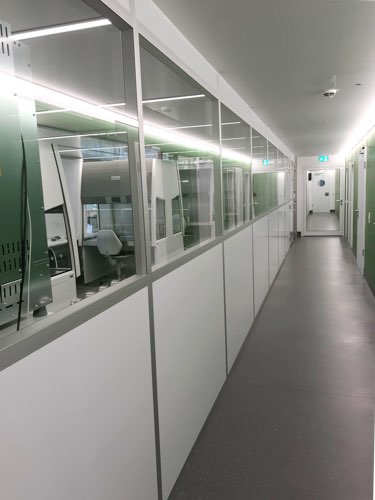The Immun-Onkologisches Zentrum Köln (IOZK) in Cologne, Germany, works on researching and developing new methods of cancer treatment. The centre needed a 100 sqm GMP cleanroom laboratory for the sterile production of the vaccines.
Since 1985, the IOZK has been employing physicians and natural scientists to research the role of the immune system in cancer. The immunotherapies developed aim to support the body’s immune system in destroying cancer cells.
Tobias Geef, Head of Purchasing and Technology at IOZK, explained the complex processes of the therapy in simple terms: “We use the biological foundations of immunology in our research and develop vaccines that activate the immune cells of the body for fighting cancer.
“Through our vaccine, the immune system is targeted specifically at the tumour antigens of the tumour to attack it. The therapy should put the immune system in a position to become active itself and fight the disease on its own. In the ideal case, the tumour is thus completely and sustainably removed by the body’s defences without side effects.”
Vaccines for fighting cancer
The combination of oncolytic viruses that can specifically attack cancer cells creates a groundbreaking approach to fighting cancer that drastically reduces the side effects of the treatment.
The IOZK has received the authorisation to develop combination agents mixed with certain viruses: the vaccines invade and alter the tumour cells. This form of therapy is still not a treatment standard but is already being made available as an individual treatment method for private patients.
In the laboratory, human cells are made to grow in special nutrient fluids and at body temperature. Foreign particles as interfering factors and any bioburden must be excluded in the process.
The production of the patient’s individual vaccines takes place in a sterile CleanSteriCell-branded cleanroom laboratory that meets the requirements for GMP cleanroom class B.
Commenting on the necessity of the new investment, Geef said: “The IOZK has several laboratories for research, diagnostics and production. For the production of the patient’s individual vaccines, we have to meet the requirements for pharmaceutical production and the requirements of the Medicinal Products Act.
“We have now invested in a brand new production laboratory with cleanroom technology. The cleanroom system corresponds to GMP cleanroom class B, is energy-efficient and is state-of-the-art; that was important to us.”
A contract win
The cleanroom laboratory was planned and built by Schilling Engineering. A special challenge resulted from the limited space conditions and the low ceiling height in the existing building.
The 100 sqm space of the cleanroom was tailored to the classified environment, and the corresponding ducting was planned for the air- conditioning technology.

The 100 sqm cleanroom laboratory was planned especially for the restricted space
The supply of ultra-pure air to the clean areas and workstations was achieved with more than 120 air changes per hour, according to the principle of low-turbulence displacement ventilation.
Filtering takes place via laminar flow units equipped with ULPA 15 high-performance filters integrated into the ceiling.
Schilling Engineering said the system is operated with a unique energy-efficient air recirculation process to reduce the high energy costs associated with the operation of a cleanroom.
A large portion of the air discharged from the cleanroom is circulated within the walls and introduced back into the circuit via the filter units.
“Because this air is already cooled and has a reduced particle count, the high costs of air conditioning are omitted,” the company explained. Also, the filter units take longer to become clogged and thus have a considerably longer service life.
GMP monitoring
Workstations for up to ten employees were set up in the new GMP laboratory. Three personnel and three material airlocks operated with different air pressure stages and air changes guarantee the purity of the laboratory system to GMP class B.
A special feature of the cleanroom laboratory is the integrated GMP-compliant monitoring. Particle count, temperature, relative humidity and air pressure are continuously monitored and recorded for the required supervision.
Serving as a control system for the cleanroom and the air-conditioning technology is the user-friendly CR Control unit, in which all setpoints, including the air-conditioning technology, are regulated and monitored. The CT Control unit is operated via a central touch screen or a mobile device.
The CleanSteriCell cleanroom system has a modular design and can be flexibly extended and converted thanks to a patented silicone-free GMP sealing clip system.
GMP-compliant LED light strips provide for pleasant and energy-saving lighting and long life span.
The cleanroom laboratory was qualified according to GMP regulations and handed over in turnkey condition by Schilling Engineering.
“The qualification of the GMP cleanroom went smoothly,” Geef said. “There are very many regulations that have to be adhered to here, but our cleanroom supplier prepared or took over everything well for us. We just went into production and are very satisfied with the way things are running,” he concluded.
